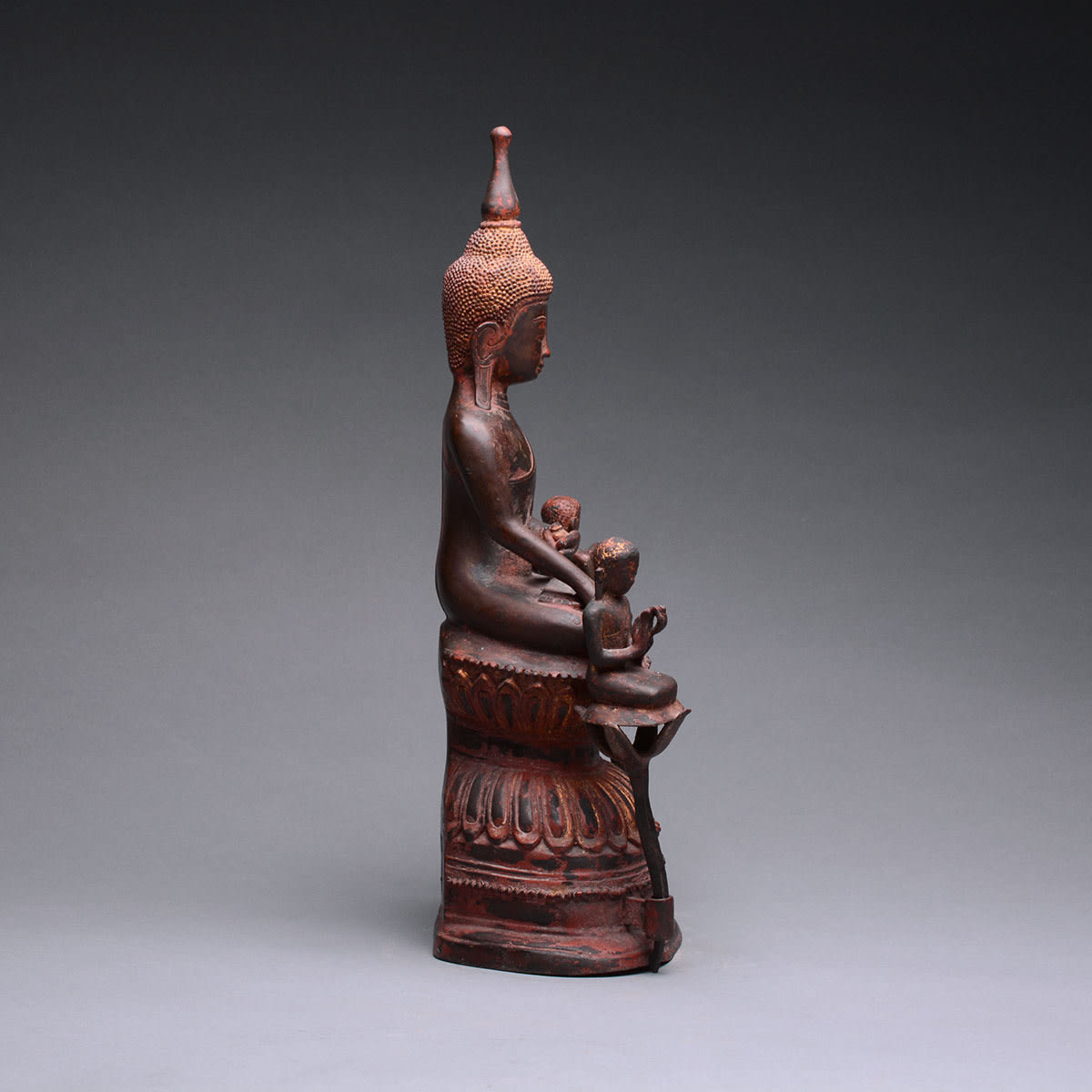Shan Bronze Sculpture of Buddha Seated on a Double Lotus Throne with Two Disciples, 18th Century CE
Bronze
38.1 x 24.1 cm
15 x 9 1/2 in
15 x 9 1/2 in
X.0236
Further images
The Shan people are a distinct ethnic group that today constitute Myanmar’s largest minority group. However, from the 13th until the 16th Century, they dominated most of the country. They...
The Shan people are a distinct ethnic group that today constitute Myanmar’s largest minority group. However, from the 13th until the 16th Century, they dominated most of the country. They are largely Buddhist, and their language and customs are closely related to the Thai and Laotians their neighbors to the south and east. In the 19th Century, long after their power had eroded, they were distributed among thirty petty states that paid tribute first to the Burman King, then to the British. This arrangement remained more or less in tact until 1922 when the Federated Shan States were joined together. In 1947, a unified Shan States was created under the Burmese Constitution. Although much of their autonomy has been relinquished to the central government, the Shan retain their unique cultural identity and ethnic heritage.
The historical figure, Buddha Gautama Sakyamuni is the Buddha of compassion who, having achieved the highest evolutionary perfection, turns suffering into happiness for all living beings. Born around 560 B.C. somewhere between the hills of south Nepal and the Rapti river, his father was a Raja who ruled over the northeastern province of India, the district including the holy Ganges River. The young prince was married to Yashoda when he was about 17 years old and together they had a son named Rahula. At the age of 29, he left his life of luxury, as he felt compelled to purify his body and make it an instrument of the mind by ridding himself of earthly impulses and temptations. This gorgeous bronze Buddha is seated in the dhyanasana position high upon a double lotus base flanked by two disciples. With his hands, the Buddha forms the bhumisparsa mudra, which can be literally translated as the “gesture of touching the earth” in which the Buddha touches the ground in order to call on the earth to witness his enlightenment. Calm and serene, he looks downwards with half closed eyes. An ushnisha crowns his head, the shape of which recalls Burmese pagodas, the main houses of Buddhist worship. This bump is symbolic of the Buddha’s enlightened wisdom and cosmic openness.
In Myanmar, two disciples traditionally flank important representations of the Buddha. Their presence is historically inaccurate, considering that all of the Buddha’s friends had deserted him at the time of his enlightenment. However, it reflects a traditional Burmese Buddhist belief that the faith was introduced into Myanmar by two of his disciples during the Buddha’s lifetime. These two disciples begin to appear as early as the 11th Century A.D. and can be identified as two of the chief disciples Mogallana and Sariputta. Here, the two are depicted in their traditional representation: seated in poses of quiet contemplation. They wear simple robes consistent with the monastic order. They are always depicted slightly smaller than the Buddha in order to reveal their status as disciples. Together, they represent an aspect of Buddhist art unique to Myanmar. This bronze sculpture of the Buddha, replete with attached disciples, is a splendid example of the Shan style that captures the Buddha in his enlightened glory.
The historical figure, Buddha Gautama Sakyamuni is the Buddha of compassion who, having achieved the highest evolutionary perfection, turns suffering into happiness for all living beings. Born around 560 B.C. somewhere between the hills of south Nepal and the Rapti river, his father was a Raja who ruled over the northeastern province of India, the district including the holy Ganges River. The young prince was married to Yashoda when he was about 17 years old and together they had a son named Rahula. At the age of 29, he left his life of luxury, as he felt compelled to purify his body and make it an instrument of the mind by ridding himself of earthly impulses and temptations. This gorgeous bronze Buddha is seated in the dhyanasana position high upon a double lotus base flanked by two disciples. With his hands, the Buddha forms the bhumisparsa mudra, which can be literally translated as the “gesture of touching the earth” in which the Buddha touches the ground in order to call on the earth to witness his enlightenment. Calm and serene, he looks downwards with half closed eyes. An ushnisha crowns his head, the shape of which recalls Burmese pagodas, the main houses of Buddhist worship. This bump is symbolic of the Buddha’s enlightened wisdom and cosmic openness.
In Myanmar, two disciples traditionally flank important representations of the Buddha. Their presence is historically inaccurate, considering that all of the Buddha’s friends had deserted him at the time of his enlightenment. However, it reflects a traditional Burmese Buddhist belief that the faith was introduced into Myanmar by two of his disciples during the Buddha’s lifetime. These two disciples begin to appear as early as the 11th Century A.D. and can be identified as two of the chief disciples Mogallana and Sariputta. Here, the two are depicted in their traditional representation: seated in poses of quiet contemplation. They wear simple robes consistent with the monastic order. They are always depicted slightly smaller than the Buddha in order to reveal their status as disciples. Together, they represent an aspect of Buddhist art unique to Myanmar. This bronze sculpture of the Buddha, replete with attached disciples, is a splendid example of the Shan style that captures the Buddha in his enlightened glory.







